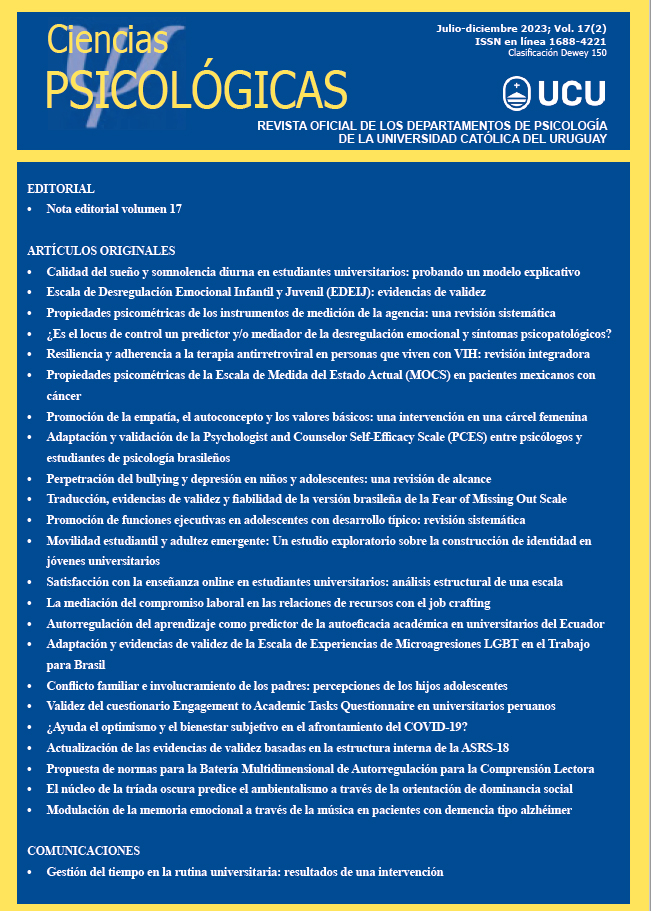Emotional Dysregulation Scale Child and Adolescent (EDEIJ): validity evidence
DOI:
https://doi.org/10.22235/cp.v17i2.2700Keywords:
emotions, validity, emotional regulation, psychological tests, sadnessAbstract
Emotional self-regulation when confronted with sad events is essential in different stages of human development, especially when it comes to children and adolescents, as different self-regulation strategies can serve as protective factors against mental disorders such as depression. This article aims to present the revised version of the Emotional Self-Regulation Scale Child and Adolescent (EARE-IJ, Escala de Autorregulação Emocional-Infantojuvenil), an instrument for measuring emotional self-regulation strategies toward sad events, with the purpose of improving it, searching for validity evidence based on the internal structure and reliability indices. The instrument was answered by 299 children and adolescents, aged 10 to 16 years (M = 12.20; SD = 1.36), and different models of confirmatory factor analysis, reliability coefficients, and an invariance model for the sex variable were tested. The results provide accumulating evidence in favor of the instrument in its new version, now known as the Emotional Dysregulation Scale Child and Adolescent (EDEIJ, Escala de Desregulação Emocional Infantojuvenil). The results also indicate that the instrument can evaluate children and adolescents with different levels of emotional dysregulation, while demonstrating configural and metric invariance. In conclusion, it is found that the tool is efficient in screening emotional self-regulation strategies in children and adolescents.
Downloads
References
American Educational Research Association, American Psychological Association & National Council on Measurment in Education. (2014). Standards for educational and psychological testing.
Barros, L., Goes, A. R., & Pereira, A. I. (2015). Parental self-regulation, emotional regulation and temperament: Implications for intervention. Estudos de Psicologia (Campinas), 32(2), 295-306. https://doi.org/10.1590/0103-166x2015000200013
Batista, H. H. V. & Noronha, A. P. P. (2018). Instrumentos de autorregulação emocional: Uma revisão de literatura. Avaliação Psicológica, 17(3), 389-398. https://doi.org/10.15689/ap.2018.1703.15643.12
Berking, M., Wirtz, C. M., Svaldi, J., & Hofmann, S. G. (2014). Emotion regulation predicts symptoms of depression over five years. Behaviour Research and Therapy, 57, 13-20. https://doi.org/10.1016/j.brat.2014.03.003
Borges, L. & Pacheco, J. T. B. (2018). Sintomas depressivos, autorregulação emocional e suporte familiar: Um estudo com crianças e adolescentes. Estudos Interdisciplinares de Psicologia, 9(3 supl.), 132-148. https://doi.org/10.5433/2236-6407.2018v9n3suplp132
Burwell, R. A. & Shirk, S. R. (2007). Subtypes of rumination in adolescence: associations between brooding, reflection, depressive symptoms, and coping. Journal of Clinical Child & Adolescent Psychology, 36(1), 56-65. https://doi.org/10.1080/15374410709336568
Chen, F. F. (2007). Sensitivity of goodness of fit indices to lack of measurement invariance. Structural Equation Modeling, 14, 464-504. https://doi.org/10.1080/10705510701301834
Cremasco, G. S., Pallini, A. C., Bonfá-Araujo, B., Noronha, A. P. P., & Baptista, M. N. (2020). Escala de Desregulação Emocional – Adultos (EDEA): Evidências de validade. Psicologia: Teoria e Prática, 22(2). https://doi.org/10.5935/1980-6906/psicologia.v22n2p83-104
Cruvinel, M. & Burochovitch, E. (2011). Regulação emocional em crianças com e sem sintomas de depressão. Estudos de Psicologia (Natal), 16(3), 219-226. https://doi.org/10.1590/S1413-294X2011000300003
Damásio, B. F. (2013). Contribuições da Análise Fatorial Confirmatória Multigrupo (AFCMG) na avaliação de invariância de instrumentos psicométricos. Psico-USF, 18(2), 211-220. https://doi.org/10.1590/S1413-82712013000200005
Dann, T. J., Baguley, T., & Brunsden, V. (2014). From alpha to omega: A practical solution to the pervasive problem of internal consistency estimation. British Journal of Psychology, 105(3), 399-412. https://doi.org/10.1111/bjop.12046
Drake, M. M., Morris, D. M., & Davis, T. J. (2017). Neuroticism’s susceptibility to distress: Moderated with mindfulness. Personality and Individual Differences, 106, 248-252. https://doi.org/10.1016/j.paid.2016.10.060
García del Castillo, J. A., Dias, P. C., & Castelar-Perim, P. (2012). Autorregulação e consumo de substâncias na adolescência. Psicologia: Reflexão e Crítica, 25(2), 238-247. https://doi.org/10.1590/S0102-79722012000200005
George, D. & Mallery, P. (2002). SPSS for Windows step by step: A simple guide and reference 11.0 update (4a ed.). Allyn & Bacon.
Gratz, K. L. & Roemer, L. (2004). Multidimensional Assessment of Emotion Regulation and Dysregulation: Development, factor structure, and initial validation of the difficulties in emotion regulation scale. Journal of Psychopathology and Behavioral Assessment, 26(1), 41-54. https://doi.org/10.1023/b:joba.0000007455.08539.94
Gross, J. J. (1998). The emerging field of emotion regulation: An integrative review. Review of General Psychology, 2(3), 271-299. https://doi.org/10.1037/1089-2680.2.3.271
Horn, J. L. & McArdle, J. J. (1992). A practical and theoretical guide to measurement invariance in aging research. Experimental Aging Research, 18(3), 117-144. https://doi.org/10.1080/03610739208253916
Hu, L. & Bentler, P. M. (1999). Cutoff criteria for fit indexes in covariance structure analysis: Conventional criteria versus new alternatives. Structural Equation Modeling: A Multidisciplinary Journal, 6(1), 1-55. https://doi.org/10.1080/10705519909540118
Muthén, L. K. & Muthén, B. O. (1998-2012). Mplus user’s guide (6a ed.). Muthén & Muthén.
Noronha, A. P. P., Baptista, M. N., & Batista, H. H. V. (2019). Initial psychometric studies of the Emotional Self-Regulation Scale: Adult and child-youth versions. Estudos de Psicologia (Campinas), 36(2), e180109. https://doi.org/10.1590/1982-0275201936e180109
Philpott-Robinson, K., Johnson, T., Evans, L., Wales, K., Leonard, C., & Lane, A. E. (2023). Measurement of Self-regulation in preschool and elementary children: A scoping review. Physical & Occupational Therapy In Pediatrics, 1-27. https://doi.org/10.1080/01942638.2022.2158055
Revelle, W. (2014). Psych: Procedures for personality and psychological research (R package version). Northwestern University.
Robson, D. A., Allen, M. S., & Howard, S. J. (2020). Self-regulation in childhood as a predictor of future outcomes: A meta-analytic review. Psychological Bulletin, 146(4), 324-354. https://doi.org/10.1037/bul0000227
Streiner, D. L. (2003). Diagnosing tests: Using and misusing diagnostic and screening tests. Journal of Personality Assessment, 81(3), 209-219. https://doi.org/10.1207/s15327752jpa8103_03
Weiss, N. H., Gratz, K. L., & Lavender, J. M. (2015). Factor structure and initial validation of a multidimensional measure of difficulties in the regulation of positive emotions. Behavior Modification, 39(3), 431-453. https://doi.org/10.1177/0145445514566504
Published
How to Cite
Issue
Section
License
Copyright (c) 2023 Universidad Católica del Uruguay

This work is licensed under a Creative Commons Attribution 4.0 International License.
















